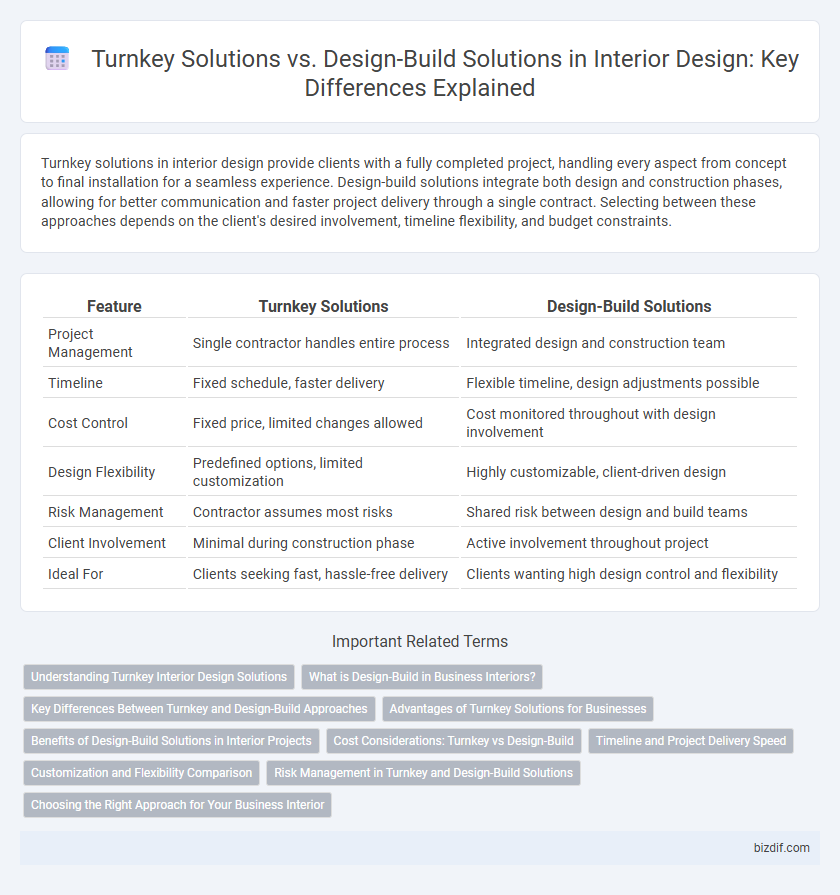Turnkey solutions in interior design provide clients with a fully completed project, handling every aspect from concept to final installation for a seamless experience. Design-build solutions integrate both design and construction phases, allowing for better communication and faster project delivery through a single contract. Selecting between these approaches depends on the client's desired involvement, timeline flexibility, and budget constraints.
Table of Comparison
| Feature | Turnkey Solutions | Design-Build Solutions |
|---|---|---|
| Project Management | Single contractor handles entire process | Integrated design and construction team |
| Timeline | Fixed schedule, faster delivery | Flexible timeline, design adjustments possible |
| Cost Control | Fixed price, limited changes allowed | Cost monitored throughout with design involvement |
| Design Flexibility | Predefined options, limited customization | Highly customizable, client-driven design |
| Risk Management | Contractor assumes most risks | Shared risk between design and build teams |
| Client Involvement | Minimal during construction phase | Active involvement throughout project |
| Ideal For | Clients seeking fast, hassle-free delivery | Clients wanting high design control and flexibility |
Understanding Turnkey Interior Design Solutions
Turnkey interior design solutions provide clients with a streamlined process where all design, procurement, and installation services are managed by a single provider, ensuring a hassle-free project completion. This approach guarantees a cohesive aesthetic and functional outcome, with predictable timelines and costs, making it ideal for clients seeking simplicity and efficiency. Turnkey solutions differ from design-build by focusing exclusively on interior elements, delivering ready-to-use spaces without requiring separate contractors or coordination.
What is Design-Build in Business Interiors?
Design-build in business interiors refers to a streamlined project delivery method where a single entity handles both the design and construction phases, ensuring cohesive communication and faster completion. This approach minimizes risks and potential conflicts between designers and contractors, providing a unified vision and accountability. Businesses benefit from cost efficiency and time savings, making design-build an attractive solution for office fit-outs and commercial space renovations.
Key Differences Between Turnkey and Design-Build Approaches
Turnkey solutions in interior design provide a complete package where the client receives a finished space ready for immediate use, managing everything from design to construction through a single contract. Design-build approaches integrate both design and construction services under one entity but often allow for more client involvement and customization throughout the process. The key differences lie in the level of client control, project timeline flexibility, and how responsibilities are allocated between design and execution phases.
Advantages of Turnkey Solutions for Businesses
Turnkey solutions offer businesses a streamlined interior design process by providing a single point of contact responsible for all project phases, ensuring seamless coordination and timely delivery. These solutions minimize risks and reduce management overhead, allowing companies to focus on core operations without worrying about contractor disputes or budget overruns. Turnkey projects often result in faster completion times and cost predictability, making them ideal for businesses seeking efficient and hassle-free interior renovations.
Benefits of Design-Build Solutions in Interior Projects
Design-build solutions streamline interior projects by integrating design and construction into a single contract, ensuring cohesive communication and faster project delivery. This approach minimizes costly design changes and enhances accountability, resulting in better budget control and higher quality outcomes. Clients benefit from a unified team that effectively manages timelines, reduces risks, and delivers tailored interior environments efficiently.
Cost Considerations: Turnkey vs Design-Build
Turnkey solutions often provide a fixed budget with minimal cost overruns, as the contractor handles all phases from design to completion, ensuring streamlined expenses. Design-build solutions may offer more flexibility in design changes but can result in variable costs due to separate phases and potential scope adjustments. Evaluating the total project cost, including design expenses, materials, and labor, is crucial when choosing between turnkey and design-build interior design methods.
Timeline and Project Delivery Speed
Turnkey solutions in interior design streamline project delivery by providing a single point of contact responsible for every phase, resulting in faster completion compared to traditional methods. Design-build solutions integrate design and construction teams early on, enhancing coordination and reducing delays, which accelerates the timeline significantly. Projects using both approaches often achieve quicker turnaround times, but turnkey contracts typically offer the most expedited delivery through consolidated management and minimized client involvement.
Customization and Flexibility Comparison
Turnkey solutions in interior design offer streamlined project delivery with predefined options but typically limit customization and flexibility, making them ideal for clients seeking efficiency and fixed costs. Design-build solutions provide greater customization and adaptability by integrating design and construction teams, allowing clients to modify plans throughout the project according to evolving preferences and site conditions. This approach enhances flexibility in material selection, layout adjustments, and innovative design features, catering to bespoke interior environments.
Risk Management in Turnkey and Design-Build Solutions
Turnkey solutions in interior design minimize client risk by delivering a fully completed project with a single point of accountability, reducing uncertainties in budget and timeline. Design-build solutions integrate design and construction teams, enhancing collaboration but requiring careful management to distribute responsibilities and mitigate potential disputes. Effective risk management in both approaches depends on clear contracts, well-defined scopes, and continuous communication to prevent cost overruns and schedule delays.
Choosing the Right Approach for Your Business Interior
Turnkey solutions offer a streamlined process where a single provider manages everything from concept to completion, ensuring consistent quality and faster project delivery. In contrast, design-build solutions integrate design and construction teams to foster collaboration, allowing for greater customization and flexibility tailored to specific business needs. Choosing the right approach depends on your priorities for control, budget, timeline, and the complexity of your interior design project.
Turnkey solutions vs Design-build solutions Infographic

 bizdif.com
bizdif.com